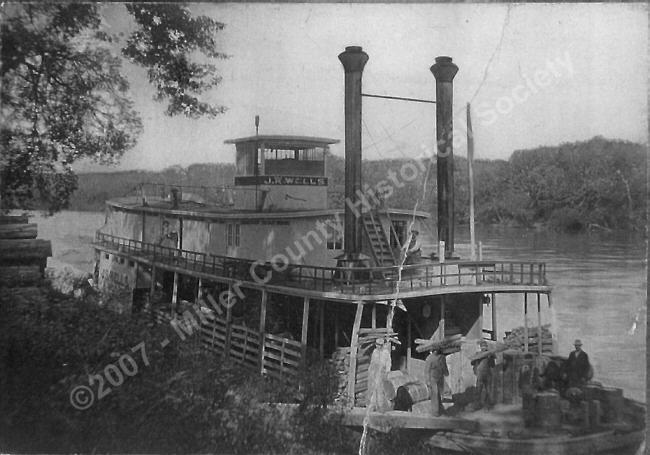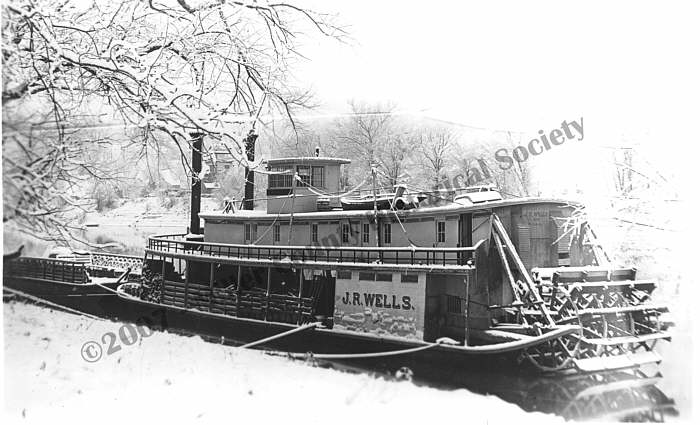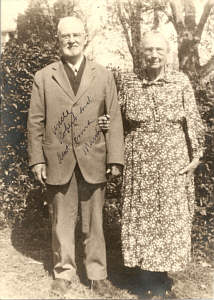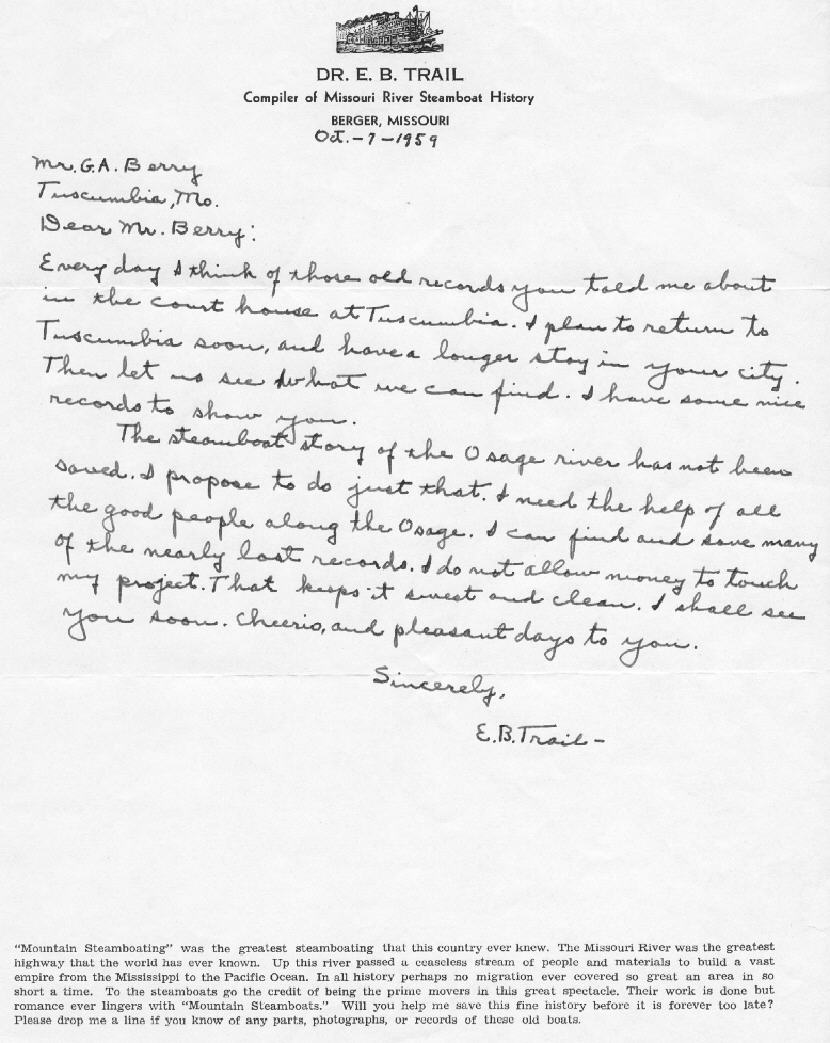
Early River NavigationEarly River Navigation Traffic on the Osage River since the earliest visit of the French explorers has played a leading part in the development of this section of Missouri. There are numerous points of ancient lore along this noble stream where incidents transpired creating stories in which a Mark Twain would revel with delight. Old steamboat men would talk about such places as Hoskins Rock, King's Bluff, Natural Bridge, Bloody Island, Bat Cave, Hurricane Deck, Lover's Leap, Big Kenslow, Little Kenslow, and Bois Bruhle to name a few-historical settings that would charm the poet's pen. Navigation on the Osage no doubt began before the advent of the white man, for when he came Indians were using the river as a means of travel. On the hills bordering the Osage may yet be found Indian mounds or burial places where the bones of this race have been found in a sitting position, proving that this was the abode of the red men. Flatboats As the white men came, the Indian canoe was superseded by the flatboat. This was back in the early 1800s. Early Frenchmen who explored Miller County, coming up the river in flatboats, left indelible proof of their visit by such names as the Bois Bruhle Creek, the Tavern, Gravois, Auglaize and many others. As the frontiersmen pushed up the Missouri and the Osage and settlements began to spring up along the Osage, flatboats became the chief means of bringing merchandise into the country and in taking out the products. These flatboats were something like 100 feet in length and sometimes six or more of these could be seen at one time at the Tuscumbia landing. The boats were propelled through the shoals where the water was shallow by six or eight men, an even number on either side. Standing on the bow of the boats, with faces downstream, they would thrust long poles into the water and as they walked to the stern of the boat, it would thus be propelled through the shallow water. Each boat was equipped with a pole some 25 feet high. From the top of this pole, a rope was carried to the bank when deep water was encountered the boat was propelled to shallow water again. This method of attaching the rope to a tall pole aided in clearing the rope from the brush along the river bank. In those days and the later days of the steamboat, Tuscumbia and Linn Creek were terminals for huge shipments of freight to the West and Southwest. Steamboats 
Among the early pioneers in steamboat traffic on the Osage, possibly there was no character which stood out more prominently than Governor McClurg. He was a man of small stature and he wore a long, flowing beard. His mode of dress included a stovepipe hat and a long-tail coat. He was a pious man, and it is said that no matter how urgent the business, when midnight on Saturday came, he tied up his boat, and the line was not touched until Sunday after midnight. His boat, "The Emma" was employed as a government boat in the 1860s and also at other times in doing a general freighting business. His run was from Osage City to Linn Creek, and at the latter place he built a home overlooking the Osage. This house was known as "McClurg's Mansion". Louis Lohman and his father were among the early navigators of the Osage and Missouri, but their main business was on the Missouri. They operated boats between St. Louis and Yellowstone River, charging $3 per cwt., and cleaning up $75,000 in one trip. Boats of the 1870s included the "Alice Gray", "Phil Chappel", "Tom Stephens", "Evening Star", "General Mead", "Gee Whiz", "Black Hills", "George Spangler", "Aggie", and "Far West". In 1880, the "Georgie Lee", the "Aggie", the "H.C. Coleman", the "Plattsmouth", the "James Watson", the "Sport", and the "Emma" are mentioned as being engaged in traffic on the Osage. The "Georgie Lee" was a side-wheeler and drew about 15 inches of water. She was in charge of Captain Henry Baker. The "H. C. Coleman", laden with merchandise for Tuscumbia merchants arrived here from Jefferson City within 24 hours of leaving the Capital City. A little later came such steamboats as the "Thos. H. Benton", the "Helena" and the "Golden Gate", all big boats. Possibly the largest and most palatial of all boats lading at Tuscumbia was the "Golden Gate", in charge of Capt. Alec Stewart. This boat was 260 feet long and was a four-decker. Above the lower deck was the cabin for the laborers. Above this was the tevas or rooms for the officers, and still above this was the pilot house. This boat was a veritable floating mansion. Those big boats made an inspiring sight at night on the river, with lights aglow and the smoke belching from the smokestacks. The big whistles on such boats can not be forgotten once they have been heard.  Then a little later came the Steamers "Hugo" and "Frederick", which, in the early days of Osage River navigation were more closely linked with Tuscumbia than any other boats, for they were owned and operated by Tuscumbia men, Capt. R.M. Marshall and Capt. Wm. H. Hauenstein. Mr. Marshall gained prominence not only on the Osage but on the Missouri River as well. In 1888 he bought the "John R. Hugo" which was an Ohio River boat. The boat was then 127 feet long, and as the boat needed some repairing, he lengthened it to 141 feet while she was on dry dock. Capt. Marshall made a success in steam-boating, his best business coming from the Lower Osage in boating wheat and on the Missouri in the government service. By aligning himself with the Missouri Pacific railroad he acquired a heavy freighting business that was consummated in an agreement between Capt. Marshall and the railroad whereby he was to deliver all his freight from Osage to the Company at Osage City and in return, the Railroad was to deliver all Osage River freight to his boat. In doing so his boat was kept busy, and the railroad secured a lot of patronage in this manner. The Railroad gave Capt. Marshall the authority to make the railroad freight rate from St. Louis or Kansas City to Osage City, and the Railroad stood by his rate. Competition between railroads and steamboats was great in those days, and Capt. Marshall says that the Railroad never violated its agreement with him. He related that he once went to Kansas City after two cars of machinery. He asked the agent at Kansas City to quote a rate to Osage City, which he stated was 55 cents. Capt. Marshall said this was too much, and suggested a rate of 12 ½ cents. The agent was stunned by this, and when he was told to call up the general freight agent at St. Louis, he did so returning with the report that it was all right. In those days there were no laws to restrict railroad freight rates, and Capt. Marshall was told to use his own judgment in making the rates, but the main point was to get the business. Steam-boating in those days was a 24-hour proposition. The "Hugo" required from 15 to 20 roustabouts and they were all Negroes. These deck hands took it for granted that they might be called upon at any time to attack a huge pile of wheat sacks on the river banks. Of course they secured some rest between landings. River traffic in those days did not stop for night. They were trying days for pilots and it was a task at times for the pilot to keep himself from falling asleep. Capt. Marshall says that one of his best plans was to hold a lead pencil in his mouth, and when he became drowsy the pencil would fall from his mouth and he would be aroused. At other times he would keep someone by his side to watch him and to shake him in case he fell asleep at the wheel. The Negro made a first rate "rousty", and Capt. Marshall employed them exclusively on the "Hugo". Some of those old roustabouts, whose names were stamped indelibly on Osage River steamboat men's minds are Sam Bennett, "Jersey", George Whitten, Phil Johnson, "Dummy", and Phil Bell. Sam Bennett made his home on the "Hugo" for 7 or 8 years, and fired the boiler at times. Capt. Marshall during one season would deliver at Osage City 85,000 sacks of wheat. He also took a contract to deliver 2,000 cords of wood per year to the State Prison at Jefferson City. Another contract with the Sullivan saddletree factory was for delivering 1,000,000 feet of lumber from Middle River. The "Hugo" usually made a trip to Tuscumbia from Osage City once a week. Capt. Marshall worked on the Missouri River or the Government six years. It seemed that the government was having difficulty in towing the barges on the Missouri owing to the heavy draft of their boats. Engineers in charge of the government work sent for Mr. Marshall and when he told them his boat could get over the shallow places, he was employed to use the "Hugo". The "Hugo" had a capacity of 2,500 sacks of wheat and its barge, the "Jumbo", could carry 5,000 sacks, making approximately 16,000 bushels of wheat that the boat and barge could handle at one trip. The government agreed to pay him $40 per day, rain or shine, for the use of the "Hugo" and for his own services. The government agreed to furnish the pilot, the deck hands and the fuel. Capt. Marshall began figuring and after he calculated that he would net about $25 per day, and with the pay sure, he made a contract with the government on this basis. Much of his work consisted of towing barges up the Missouri to St. Joe, Omaha, Council Bluffs, Nebraska City and Plattsmouth. The "Hugo" wintered at some of these places.
In the following year (1882) the Bagnell Branch of the Missouri Pacific was built and the steamer mail was soon discontinued. The company started to build another boat for the Osage River service, but after they completed the hull, which was 130 feet long and 25 feet wide, they decided to use it as a barge, which they did in connection with the "Tuscumbia". Messrs. Woolery & Loucks of Jefferson City were also interested in this corporation. The Str. "Tuscumbia" will be remembered by Tuscumbia people as the boat of tragedy as it was from this boat that Mrs. Wm. H. Hauenstein fell into the river one night while she and Mr. Hauenstein were returning from St. Louis and she was drowned. Possibly the last time she was seen alive was by Mr. Sanning who was on the boat coming from Jefferson City. Mr. Sanning was an aged man and he and Mrs. Hauenstein talked for some time after Mr. Hauenstein had retired for the night. According to his version, Mrs. Hauenstein must have fallen from the boat somewhere within 15 miles of Tuscumbia. The body was never recovered although a diligent search was made. The "Black Diamond", the "Aggie", and the "Hulburg" were also among the boats navigating the Osage in the eighties. The "Aggie" was a towboat, equipped with two boilers. She was in charge of Capt. Roby. In 1882, Capt. Wm. H. Hauenstein, who was engaged in the mercantile business at Tuscumbia with his father, Wm. Hauenstein, built the Str. "Frederick", primarily to haul their freight from Osage City and to deliver produce to the railroad. The boat was built in 1882 near Ralph Wells' home. The "Frederick" was 100 feet long and 14 feet wide. In 1883, Capt. Marshall bought one-half interest in the "Frederick", and later bought out Capt. Hauenstein, and Capt. Marshall then owned the "Hugo" and the "Frederick".
The Anchor Milling Company also built a large barge, the "Ida", which was used to advantage in the Osage River service. The "Wells" and its barge could handle approximately 6,000 bushels of wheat at a trip. The "Dauntless" was another steamboat which was built at Tuscumbia about the time the "J.R. Wells" was launched. This boat was equipped with a tubular boiler, and was about 60 or 75 feet in length. It was built by a company of Tuscumbia businessmen for general freighting on the Osage. The "Ruth", another boat built by J.R. Wells, was later operated in traffic by the Anchor Milling Company.  The J.R. Wells in Winter  The two people in the left foreground are George Washington Edwards and his wife Tennessee Barnhart Edwards. The Anchor Milling Company disposed of the "J.R. Wells" to Missouri River interests and later built the "Homer C. Wright", which was used in hauling wheat from various points along the Osage River to the flour mills here and also to the railroad. The boat also did a general freighting business, handling quite a lot of livestock. C.B. Wright, who served a number of years as Clerk on the "J.R. Wells", later became a pilot on the "Ruth" and "Homer C. Wright". He grew up with the business and became president of the Anchor Milling Company, one of the largest concerns in the county. Volumes could be written about the steamboat days on the Osage River during the 19th century. Those boats, mostly stern-wheelers, did a valuable service during that period of time following the close of the Civil War up until the year of 1910. As the railroads came into being with their methods, in early days of cutting rates to put the steamboats out of business, the boating business soon became unprofitable. Facts compiled in 1937 revealed it cost less to ship a carload of merchandise from St. Louis to Buenos Ayres, South America by the all-water routs, down the Mississippi and by steamship, than it cost by rail from St. Louis to Denver. It cost less to ship a carload of merchandise to Singapore, half-way around the world, than from St. Louis to Salt Lake City. Army engineers began working on a plan to make the Mississippi, Missouri and Ohio Rivers and their large tributaries navigable. Their hope was to curb the ever-changing Missouri River channel and make the Missouri and Osage Rivers valuable means whereby bulky freight could be moved at a big savings in transportation costs to the people of the great Middle West. CAPTAIN ROBERT MELVILLE MARSHALL
|
 |
Robert Melville Marshall was born at Aurora, Illinois, on October 9, 1858. His father, David Marshall, came to the United States to make a home for himself and his future wife, Mary Burwell. Miss Burwell came a little later, and after their marriage they settled at Aurora, Illinois. Later they moved to Chicago, and in 1870, to Tuscumbia, where both Mr. and Mrs. Marshall died. They had two children, Lena and Robert Melville.
Mr. Marshall attended public school at Chicago and continued his education by going to school at Tuscumbia. He was employed for six years as a printer in the newspaper offices of the Miller County Helmet and the Miller County Vidette. About this time he took a trip up the Osage River as far as Osceola, and from there to Fort Smith, Kansas. He became greatly attracted to river life, and upon his return to Tuscumbia, definitely decided to go into the river steamboat business.
At first he handled the freighting business on the upper river, and Captain Henry Castrop and others handled that on the lower river. Captain Marshall was well suited to this kind of work. He was cool and fearless, a man of strong will and determination. In 1881 he became united in marriage with Miss Emma Hauenstein, youngest child of Captain William H. Hauenstein, Sr. The Christian Character of his wife caused her to be reverenced not only in her own home but among the men along the rivers.
In 1888 a consolidation was made of the upper and lower river lines, with Captain Marshall at the head, while Captain Castrop did the office work. Within a year the business had increased so much that the one boat which they had could no longer take care of it. Two more boats were purchased. The immense energies of Captain Marshall brought remarkable results. The company, which covered the entire Osage and down to St. Louis on the Missouri and Mississippi Rivers, was incorporated under the name of Osage and Missouri River Packet Company, of which Captain Marshall was manager and Captain F.G. Schoenen was agent.
In 1898 ill health caused Captain Marshall to retire from the river. Two years later he and Mrs. Marshall took a visit to Europe. He organized in 1902 the Bank of Tuscumbia, of which he was president until his retirement thirty years later. He was one of the organizers of the company which built the bridge across the Osage River at Tuscumbia, and superintended the erection of that structure. In 1915 he donated the land for the Tuscumbia Park. For many years he was president of the Anchor Milling Company.
Politically, Captain Marshall is a Republican. He is a member of the Presbyterian Church, and is affiliated with the Royal Arch Chapter of Masonry. Throughout his life Captain Marshall has shown indefatigable industry, strong personality, and business acumen.
Steamboating on the Osage River
from the memory of Bamber Wright
Osage River Steamer
|
Mile Marker
|
|
|
|
|
Grant Marsh was the pilot of the Far West and brought the survivors back from the Battle of the Little Big Horn, making record time.

Steamboat Researcher and Author

|
P.O. Box 57 Tuscumbia, MO 65082 http://www.MillerCountyMuseum.org © 2007 - Miller County Historical Society millercountymuseum@att.net |

|

